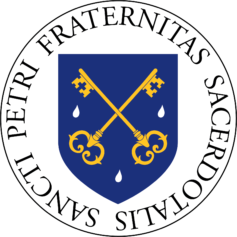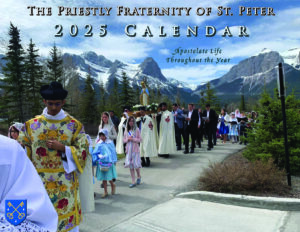Diaconate Ordinations Today!
Today at 10am Central Time, His Excellency the Most Reverend Joseph Perry, Auxiliary Bishop of Chicago, will ordain nine men to the diaconate at Our Lady of Guadalupe Seminary. It is at this point that the candidates enter into Major Orders and the seven from the FSSP become permanent members of the Fraternity. Please pray for them as they take this important step!
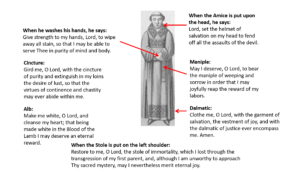 One of the most notable elements of the diaconate ordination ceremony is the investiture of the candidates in the stole and the dalmatic. Perhaps you have wondered about the meaning of each item that the deacon wears. Each piece is rich with history and symbolism and carries with it particular prayers that the bishop says at the investiture of each deacon, which you can read below. The handy illustration above shows which item is which and the prayers that the deacon says each time he vests himself.
One of the most notable elements of the diaconate ordination ceremony is the investiture of the candidates in the stole and the dalmatic. Perhaps you have wondered about the meaning of each item that the deacon wears. Each piece is rich with history and symbolism and carries with it particular prayers that the bishop says at the investiture of each deacon, which you can read below. The handy illustration above shows which item is which and the prayers that the deacon says each time he vests himself.
Amice
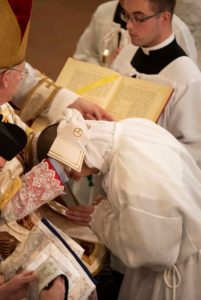
Origin: An accessory to men’s dress which appeared in Republican Rome in the 3rd century B.C.
Investiture Prayer (subdiaconate): Receive the Amice, by which the watch over one’s voice is signified. In the name of the Father and of the Son and of the Holy Ghost.
Alb
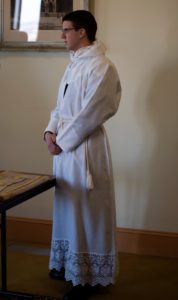
Origin: Roman tunic (and other Greek and Roman clothing)
The candidate enters wearing the alb (from the Latin “albus”, meaning “white”), a longer form of the surplice.
Maniple
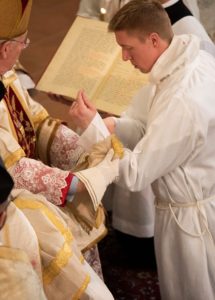
Origin: Mappa/Mappula – plain linen napkin used by Greeks and Romans at meals to wipe mouth and hands.
Investiture Prayer (subdiaconate): Receive the Maniple, by which the fruits of the good works are signified. In the name of the Father and of the Son and of the Holy Ghost.
Stole

Origin: Sudarium/Orarium/Stola – Roman handkerchief for wiping face and nose (1st century B.C.)
Investiture Prayer: Receive this shimmering stole from the hand of God, fulfill thy ministry; for God is powerful to increase His grace in thee. Who liveth and reigneth world without end.
Dalmatic

Origin: From Dalmatia (introduced into Roman society ~A.D. 200)
Investiture Prayer: May the Lord clothe thee with the garment of salvation and the vestment of joy, and may He encompass thee always with the Dalmatic of justice. In the Name of the Lord.
Our thanks to Mr. William Rock, FSSP, who will be ordained a deacon today, for the information on the deacon’s vestments and the illustration.
March 30, 2019
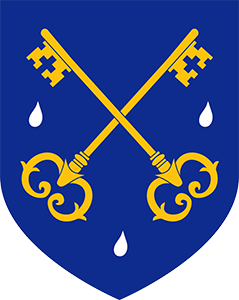
Visit Our New Events Page!
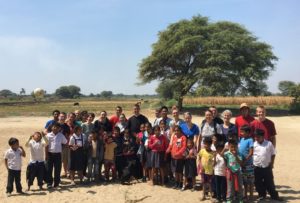
You may have noticed a minor change in the navigation bar on our website. If you click on the recently-added “Events” link, it will take you to a brand-new page where you can find information about FSSP retreats, pilgrimages, camps and other events. While it doesn’t include local events, that is, events that are only doable for people at a particular parish or small geographical area, it includes information and sign-up links for most of our larger-scale happenings, such as the Saint Francis Xavier Mission Trips that attract youth and families from all over the country. We hope you will find the new page a helpful resource if you are looking for some time away at a retreat, to sign up early for the ever-popular boys’ camps in Pennsylvania and South Dakota, or to see when the annual Buckley March is happening.
Bookmark www.fssp.com/events to stay up-to-date with all the goings-on, and share the page with your family and friends!
N.B. If your parish is hosting an event that you think folks from other regions and states might be interested in – such as summer camps that are open to other parishes – feel free to email us at missive@fssp.com and we’ll include it!
March 27, 2019

Happy Feast of the Annunciation!
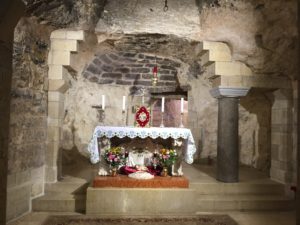
A happy and most glorious feast of the Annunciation of Our Lady! Today we celebrate the wondrous message brought to a humble Virgin of Nazareth by an angelic visitor, who told her that God had chosen her to be the Mother of the Savior. Her response, her unequivocal and whole-hearted fiat, “let it be done”, changed the course of human history, the Word of God coming to earth at that moment for our salvation.
Let us give thanks to God this day for Mary’s “yes” and for the coming of the Son of God that occurred on this beautiful day. Let us also strive to imitate in our own lives Our Lady’s complete, joyful, trusting abandonment to the Will of God and her ardent dedication to the fulfillment of His Will at every moment of her life.
Dixit autem María: Ecce ancílla Dómini, fiat mihi secúndum verbum tuum.
And Mary said: Behold the handmaid of the Lord, be it done to me according to thy word.
Luke 1:38
March 25, 2019

Just Like the Ardennes
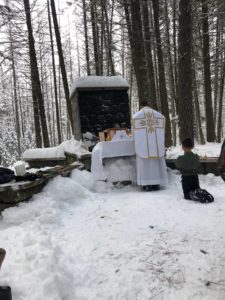 If a picture is worth a thousand words, there’s also a story behind every picture. You may have seen the now-famous photograph of FSSP Coeur d’Alene pastor Fr. Dennis Gordon celebrating Mass in the snowy wilderness of northern Idaho. Kneeling in the snow and serving Mass is a small, uniformed boy who does not seem to be over-bothered by the cold, and summed up by all aspects of the image is the idea that there is something going on here that transcends cold, hardship and the privations of a wilderness encampment that, while not being so far from home (Farragut State Park is about 30 minutes from the parish), might give you a good taste of such a life. The occasion of the Mass was a frigid campout of the FSSP Couer d’Alene detachment of the Troops of St. George, a Catholic scouting group that has, during the last few years, offered Catholic families an alternative to the Boy Scouts. Parishioner Travis Rawlings, leader of the parish’s Troops, was present at the campout with his young son and he snapped the photos of the snowy morning Mass, which Fr. Gordon celebrated on a portable altar after it had snowed most of the night. Crafted by parishioner and local carpenter Rick Murphey and dubbed the “Wilderness Altar” by Fr. Gordon, the altar was the first of its kind produced by Mr. Murphey’s St. Joseph’s Apprentice workshop and the model has kept the name ever since. After Mass, when Fr. Gordon attempted to pour out the Lavabo water, it was no longer a liquid but ice, frozen to the bowl!
If a picture is worth a thousand words, there’s also a story behind every picture. You may have seen the now-famous photograph of FSSP Coeur d’Alene pastor Fr. Dennis Gordon celebrating Mass in the snowy wilderness of northern Idaho. Kneeling in the snow and serving Mass is a small, uniformed boy who does not seem to be over-bothered by the cold, and summed up by all aspects of the image is the idea that there is something going on here that transcends cold, hardship and the privations of a wilderness encampment that, while not being so far from home (Farragut State Park is about 30 minutes from the parish), might give you a good taste of such a life. The occasion of the Mass was a frigid campout of the FSSP Couer d’Alene detachment of the Troops of St. George, a Catholic scouting group that has, during the last few years, offered Catholic families an alternative to the Boy Scouts. Parishioner Travis Rawlings, leader of the parish’s Troops, was present at the campout with his young son and he snapped the photos of the snowy morning Mass, which Fr. Gordon celebrated on a portable altar after it had snowed most of the night. Crafted by parishioner and local carpenter Rick Murphey and dubbed the “Wilderness Altar” by Fr. Gordon, the altar was the first of its kind produced by Mr. Murphey’s St. Joseph’s Apprentice workshop and the model has kept the name ever since. After Mass, when Fr. Gordon attempted to pour out the Lavabo water, it was no longer a liquid but ice, frozen to the bowl!
Fr. Gordon, himself a former member of the Coast Guard, mentioned that the conditions were reminiscent of what Allied troops may have faced during the Battle of the Bulge in World War II. Also known as the Ardennes Counteroffensive, the Battle of the Bulge took place during the winter of 1944-45 in the dense forests of the Ardennes region of eastern Belgium, Luxembourg and France and successfully repelled a German attempt to break through weak spots in the advancing Allied lines. It was a victory for the Allies and would be the last major German offensive on the Western Front.
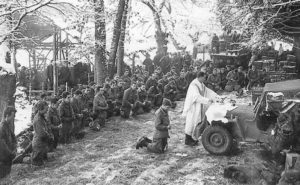
But victory came at a cost; what was named “undoubtedly the greatest American battle of the war” by Winston Churchill was also the deadliest for US forces. Soldiers spent Christmas far from their families and homes, and many of them, some 19,000 Americans, lost their lives in a battle made all the more brutal by the vicious winter weather. Yet for them, as for the diminutive Troops who emulated them a few weeks ago in Idaho, the Blessed Sacrament was a light in a dark place. Black and white photographs bear testament to the faith and courage of chaplains who celebrated Mass on jeeps, in warehouses or on the battlefield itself and of the men, many of them not much older than the Troops in Idaho, who knelt down in a world of death to draw strength from the Bread of Life.
 In an age where masculine role models are becoming increasingly hard to come by, there was something eminently fitting about what happened in Idaho that frosty day and the comparisons it evoked. Though separated by several generations, the young Troops and the wartime troops of yesteryear were united in the Faith they professed, and in the fortitude that made the challenges of the winter wilderness small things to bear for its sake. Not all of us are called to fight physical battles, but all are called to the spiritual battle, and as time continues to pass and we gradually say goodbye to those who heard Mass gathered around jeeps in the Ardennes and Iwo Jima, may new generations of young men rise up to imitate their courage, their spirit of sacrifice, and their undying faith.
In an age where masculine role models are becoming increasingly hard to come by, there was something eminently fitting about what happened in Idaho that frosty day and the comparisons it evoked. Though separated by several generations, the young Troops and the wartime troops of yesteryear were united in the Faith they professed, and in the fortitude that made the challenges of the winter wilderness small things to bear for its sake. Not all of us are called to fight physical battles, but all are called to the spiritual battle, and as time continues to pass and we gradually say goodbye to those who heard Mass gathered around jeeps in the Ardennes and Iwo Jima, may new generations of young men rise up to imitate their courage, their spirit of sacrifice, and their undying faith.
We leave you with the words of a Belgian immigrant who commented on the Idaho photo on Facebook: “I am a native Belgian who immigrated to the U.S. at age 15 – 35 years ago. When I first saw this picture on my news feed, I exclaimed, “It’s just like the Ardennes in WWII!!” I am keeping this picture!”
We’re keeping it too. +
March 20, 2019

Happy Feast of St. Joseph!

A happy and most glorious feast of St. Joseph, spouse of Our Blessed Mother and foster-father of Jesus! With the exception of Our Lady herself, no human being was closer to Our Lord than St. Joseph. It is for this reason that the saints counsel us to go to Joseph in all our needs. As St. Teresa of Ávila says:
To other Saints Our Lord seems to have given power to succor us in some special necessity – but to this glorious Saint, I know by experience, He has given the power to help us in all. Our Lord would have us understand that as He was subject to St. Joseph on earth – for St. Joseph, bearing the title of father and being His guardian, could command Him – so now in Heaven Our Lord grants all his petitions.
– from the autobiography of St. Teresa
Today is a first-class feast, a break, you might name it, in the midst of our Lenten penances. We encourage you to attend Mass in honor of St. Joseph today if you can, and to begin or renew your devotion to this most powerful intercessor.
We also wish a happy patronal feast day to our apostolates dedicated to St. Joseph in Rockdale, IL, Richmond, VA and Tacoma, WA.
Do not be afraid, Joseph, son of David, to take to you Mary your wife, for that which is begotten in her is of the Holy Spirit. And she shall bring forth a Son, and you shall call His name Jesus; for He shall save His people from their sins.
– Matthew 1:20-21, from the Gospel for today
March 18, 2019

Ember Days of Lent
Today, Friday and Saturday constitute the Ember Days of Lent. In the most recent edition of Meménto, we included the following article by FSSP Quincy pastor and former Superior General Fr. Arnaud Devillers, who explains the history of the Ember Days and their place in the liturgical calendar.
by Fr. Arnaud Devillers, FSSP
What are Ember Days? Ember Days are three days (Wednesday, Friday and Saturday) set apart in each of the four seasons for fasting, abstinence and prayer. Tied to the seasonal cycles of farming and harvesting, the purpose of Ember Days is to render thanks to God for the gifts of Creation and to ask His help in using them well. Since 1966, the fasting and abstinence are no longer prescribed but still encouraged.
What is the origin of Ember Days? Pin-pointing the exact date may be challenging, but what is certain is that they originate in Rome within the first centuries of the Church. Pope St. Leo the Great (mid 5th century) has left a series of beautiful sermons for these days and thought they had been instituted by the Apostles themselves. The Liber pontificalis dates their institution to Pope St. Calixtus (218-225), though they were more probably instituted by Pope Siricius (384-399).
In her early days, the Church in Rome was confronted with a number of pagan religious nature festivals. Outstanding among them was the threefold seasonal observance of prayer and sacrifices to 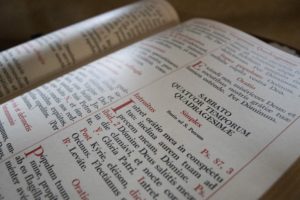 obtain the favor of the gods upon sowing and harvest. The first of these seasonal celebrations occurred at various dates between the middle of November and the winter solstice. It was a time of prayer for successful sowing (Feriae sementivae: Feast of Sowing). The second festival was held in June for the grain harvest (Feriae messis: Harvest Feast). The third one came before the autumnal equinox (September) and was motivated by the grapes harvest (Feriae vindimiales: Feast of Wine).
obtain the favor of the gods upon sowing and harvest. The first of these seasonal celebrations occurred at various dates between the middle of November and the winter solstice. It was a time of prayer for successful sowing (Feriae sementivae: Feast of Sowing). The second festival was held in June for the grain harvest (Feriae messis: Harvest Feast). The third one came before the autumnal equinox (September) and was motivated by the grapes harvest (Feriae vindimiales: Feast of Wine).
As the empire became officially Christian, the Church tried to sanctify these seasonal festivals. The first regulations mention only “Three Seasons”. Eventually, the Church added a fourth prayer period (in March). This change seems to have been motivated by the fact that the year contains four natural seasons, and also by the mention of four fasting periods in the Book of Zechariah (8:19). At about the same time, each period was extended over the three traditional Station days (Wednesday, Friday, Saturday). While the Station fast at other times was expected but not strictly prescribed, this seasonal observance imposed fasting by obligation. The Eucharistic Sacrifice was offered after having fasted the whole of Saturday and having performed a long vigil service of prayers and readings, lasting the greater part of the night.
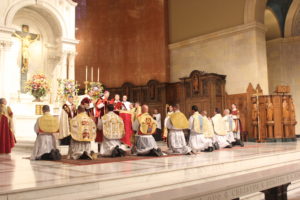
In 494, Pope Gelasius I prescribed that the sacrament of Holy Orders be conferred on Ember Saturdays. Thus the prayer and fasting of Ember week acquired added importance, for apostolic tradition demanded that ordinations be preceded by fast and prayer (Acts 13:3). Not only did the candidates themselves fast and pray for a few days in preparation for Holy Orders, but the whole clergy and people joined them to obtain God’s grace and blessing upon their calling. Thus Embertides became like spiritual exercises for all, similar in thought and purpose to our modern retreats and missions. Ember Days have been used at times as special prayers by the faithful for vocations to the priesthood and for the sanctification of priests.
Why are they called “Ember Days”? The words have nothing to do with embers or ashes. It may be from the Anglo-Saxon ymbren, a circle or revolution; or more likely it may be a corruption of quatuor tempora through Dutch, Danish or German (Quatember).
What are the dates of Ember Days? They have fluctuated throughout history. The upcoming Ember Days of Lent were not originally linked to the first week of Lent but to the first week in March. Francis Mershman in the Catholic Encyclopedia (1908) affirms: “They were definitely arranged and prescribed for the entire Church by Pope Gregory VII (1073-1085) for the Wednesday, Friday, and Saturday after 13 December (S. Lucia), after Ash Wednesday, after Whitsunday, and after 14 September (Exaltation of the Cross).” This was expressed in the old English rhyme:
Fasting days and Emberings be
Lent, Whitsun, Holyrood, and Lucie.
Or even a shorter mnemonic: Lenty, Penty, Crucy, Lucy.
Since the publishing of the Catholic Encyclopedia, the dates have changed again. According to the Extraordinary Form of the Roman Missal (1962), the Advent Ember Days are the Wednesday, Friday and Saturday of the third Week of Advent and the September Ember Days are the Wednesday, Friday and Saturday of the third week of September. In the Ordinary Form, the dates for them must be determined by the Conference of Bishops (#46).
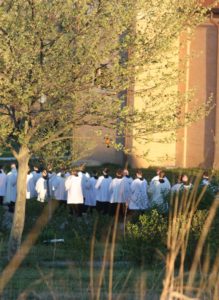 Ember Days remind us of a time when society was mostly rural. In our urban society, the connection between Ember Days and the cycle of sowing and harvest does not speak to most of us any longer. However, the association of Ember Days and ordinations could give a new purpose to Ember Days as voluntary days of penance by clergy and faithful together, to not only confess and atone for sins of the past but also to pray for more vocations to the priesthood and the sanctification of clergy. +
Ember Days remind us of a time when society was mostly rural. In our urban society, the connection between Ember Days and the cycle of sowing and harvest does not speak to most of us any longer. However, the association of Ember Days and ordinations could give a new purpose to Ember Days as voluntary days of penance by clergy and faithful together, to not only confess and atone for sins of the past but also to pray for more vocations to the priesthood and the sanctification of clergy. +
March 13, 2019

FSSP Ottawa Publishes History of Parish
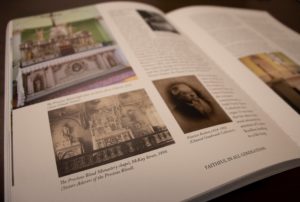
St. Clement Parish, our apostolate in Ottawa, Canada, recently published a new book in celebration of its golden anniversary. Faithful in All Generations: A History of St. Clement Parish, Ottawa 1968-2018 chronicles the parish’s fascinating 50-year history, including its origins at the Monastery of the Sister Adorers of the Precious Blood in 1968, the coming of the Fraternity in 1995 and the parish’s move to the historic church of St. Anne in 2011. Beautiful color photographs are included throughout and copies of foundational documents provide valuable historical data. The book is the fruit of over three years of work by many dedicated volunteers, including parishioners of this extraordinary apostolate.
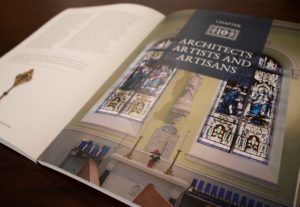 The story of Saint Clement Parish is truly an inspiration for all. It is an eloquent reminder as well to always seek the best in divine worship, for the glory of God and the salvation of souls.
The story of Saint Clement Parish is truly an inspiration for all. It is an eloquent reminder as well to always seek the best in divine worship, for the glory of God and the salvation of souls.
– His Eminence Raymond Cardinal Burke
You can buy Faithful in All Generations right here at Fraternity Publications.
March 11, 2019

Our Lenten Reading List
Lent is upon us. Adding some spiritual reading to our daily devotions is an excellent way to deepen our spiritual life, and Lent is the perfect time to take up this practice or to tailor our current regimen to the particular mysteries of the season. If you’re not sure where to begin, our Lenten reading list will get you started. Such spiritual masters as Venerable Fulton Sheen and St. Thomas Aquinas offer a wealth of insights and inspirations to help us reap more abundantly the great graces of this time of the liturgical year.
All the books listed below are available at our bookstore, Fraternity Publications. Use the code #10LENT for 10% off your order during the entire month of March!
Lent and Easter: Wisdom from Fulton J. Sheen
Lenten Meditations with Fulton J. Sheen
The Sadness of Christ by St. Thomas More
The Dolorous Passion of Our Lord Jesus Christ by Anne Catherine Emmerich
Meditations for Lent from St. Thomas Aquinas
Revelations of St. Bridget
The Way of the Cross According to the Method of St. Alphonsus Liguori
The Agony of Jesus by St. Pio of Pietrelcina
Passio Christi: Meditations for Lent by Mother St. Paul
Be sure to check out our Lenten music selections as well!
In Cena Domini: Maundy Thursday at Our Lady of Guadalupe Seminary
Lux in Tenebris: Holy Week at Mater Dei
March 7, 2019

Ash Wednesday
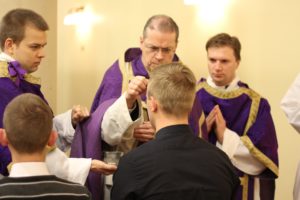
Today is Ash Wednesday, the beginning point of the Lenten season. The ashes that we receive today are a reminder of our own mortality, that our time here on earth is short and we must look to the state of our souls while we still have the opportunity to do so. Knowing our human weakness and our extraordinary powers of procrastination, the Church in her wisdom gives us the forty days of Lent every year as a unique opportunity to assiduously separate ourselves from earthly attachments through penance, and to actively attach ourselves to heavenly things through added spiritual practices – perhaps daily Mass, a regimen of spiritual reading or some charitable works. Check with your local parish to see their schedule of Lenten devotions, which often include a parish mission or perhaps weekly Stations of the Cross on Fridays.
Today and Good Friday are days of obligatory fast and abstinence, and each Friday of Lent is an obligatory day of abstinence. Let us not view the next six weeks with trepidation, but rather let us embark upon this holy season with the same diligence and confidence reflected in the prayer the priest says after the distribution of the ashes:
Grant us, O Lord, to take up our duty as soldiers of Christ by holy fasting that we, who are to do battle with the evil spirits, may be protected by the help of self-restraint.
March 6, 2019

Diaconate Ordinations: March 30th, 2019
The nine men who were recently ordained to the subdiaconate at Our Lady of Guadalupe Seminary will soon advance to the diaconate, the last stage before their priestly ordinations. His Excellency the Most Reverend Joseph Perry, Auxiliary Bishop of the Archdiocese of Chicago, will come to the seminary to confer the ordinations during a Solemn Pontifical Mass on Saturday, March 30th, at 10 am. All are welcome to attend.
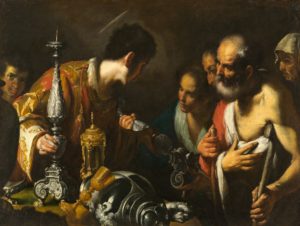
In addition to closely assisting the priest at the altar, one of the particular offices of the deacon is to chant the Gospel, and hence during the ceremony each of the ordinandi lays his hand on the book of the Gospels presented to him by the Bishop. Historically, deacons were also entrusted with the distribution of goods to the poor; indeed, a complaint about the neglect of certain widows in these distributions gave rise to the installation of the first seven deacons, ordained by the Apostles themselves (Acts 6:1-6). One of these seven was the Church’s first martyr, St. Stephen, and among the early saints we find other examples of holy deacons, such as the illustrious St. Lawrence, who famously distributed the Church’s treasures among the poor to prevent their confiscation by the persecuting authorities.
Please pray for these seven subdeacons and the two from the Sons of the Most Holy Redeemer as they prepare for their diaconate ordinations!
The 2019 diaconate ordinandi for the Priestly Fraternity of St. Peter:
Mr. Javier Ruiz Velasco Aguilar
Jalisco, Mexico
Mr. Daniel Alloy
Bellevue, Nebraska
Mr. Eric Krager
Durham, Pennsylvania
Mr. Joseph Loftus
Coeur d’Alene, Idaho
Mr. David McWhirter
Kunkletown, Pennsylvania
Mr. William Rock
Caldwell, New Jersey
Mr. Thomas Sofatzis
Hurstville, Australia
March 1, 2019


